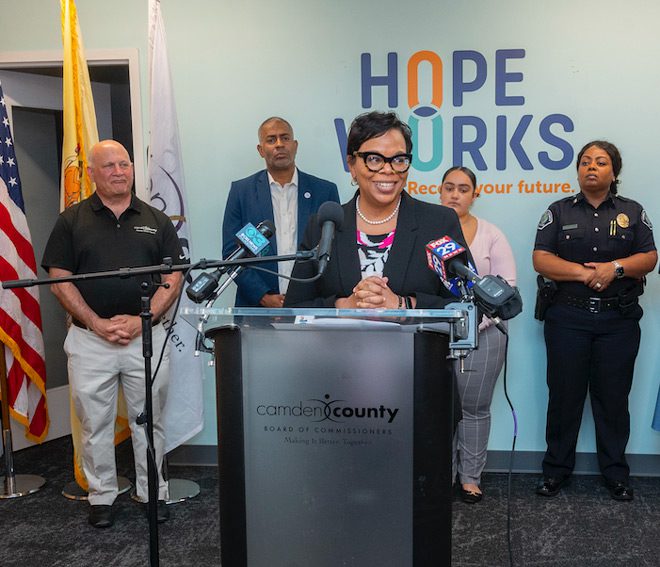Connecting Camden

In Camden, where billions in investment dollars have sparked a wave of economic revitalization, the city is committed to making sure that local residents are a part of this mission.
Camden Works is a community-driven initiative that has been dismantling employment barriers and building career pathways – connecting Camden residents to not just any job, but to meaningful, long-term opportunities. Powered by a diverse coalition of partners and a deep commitment to equity, Camden Works is proving that with the right support, economic mobility isn’t just possible – it’s within reach.
Driving Career Connections and Economic Mobility for Camden Residents
Since its launch in 2019, Camden Works has been reshaping the employment landscape in Camden by directly connecting residents with job opportunities in the city’s growing economy.
The initiative was created in response to a clear need: While Camden received more than $2.5 billion in investments between 2015 and 2019, a gap remained between local jobseekers and the employers moving into the city. Camden Community Partnership, a nonprofit focused on community and economic development, stepped in to lead the way.
“At the heart of it all, our goal is to support Camden residents and ensure they have access to the full range of services needed to succeed in their career aspirations,” says Dana Redd, President and CEO of Camden Community Partnership.
Since its founding, and with the leadership and support of several partners like George E. Norcross III, Chairman of Cooper University Health Care, Lara Price, chief operating officer of the Philadelphia 76ers, and Mark McDonough, president of New Jersey American Water, Camden Works has served over 1,400 residents – connecting them to meaningful career pathways. Partnering with major employers such as American Water, the 76ers and ResinTech, the initiative has leveraged the city’s economic revitalization to create lasting opportunities for residents.
“This isn’t just about landing a job – it’s about accessing a career and making sure we’re positioning people for long-term economic mobility,” says Redd.
A major strength of Camden Works lies in its collaboration with organizations like the NAACP New Jersey State Conference, Hopeworks, Camden County College, LAEDA and the Camden County Workforce Development Board. These groups help deliver supportive services, from resume building and job training to entrepreneurship resources.
“Each of these partners brings critical resources to the table,” says Redd. “We’re not trying to recreate or replace what any of them already do – we’re working together, as a united coalition.”
Camden Community Partnership also launched the Camden Loop, a micro-transit service that provides $2 rides to jobs, healthcare and grocery stores, with over 100,000 rides completed since its 2023 debut.
“We’re working to break down longstanding transportation barriers,” says Redd.
The program’s outreach has expanded digitally through a weekly job board newsletter, which promotes job listings, training sessions and support services. Employers are encouraged to submit job postings and training events, which Camden Works shares free of charge.
Through initiatives like these, Camden Community Partnership continues to put residents first.
“Community engagement is at the heart of our efforts,” says Redd. “It’s not just about bricks and mortar – it’s also about refining the ways we support the success, vision and dreams of our Camden residents. We’re all focused on doing our part to make Camden a vibrant community – a vibrant city. I truly believe we’re headed in the right direction.”

“At the heart of it all, our goal is to support Camden residents and ensure they have access to the full range of services needed to succeed in their career aspirations.” – Dana Redd President and CEO, Camden Community Partnership
Creating Career Pathways for Camden Youth
In a city where economic revitalization is creating new opportunities, the Camden Education Fund (CEF) is working to ensure that Camden’s young people are prepared to seize them. Through a growing partnership with Camden Works, CEF is helping high school students explore job opportunities, develop career skills and envision a future shaped by their interests and strengths – whether that includes college, a trade or entering the workforce directly.
“We believe strong career pathways start with early exposure opportunities for our young people – opportunities to really build skills,” says Giana Campbell, CEO of Camden Education Fund. “So we’ve partnered with Camden Works around some of their job initiatives to ensure that not only are residents getting access to and information about local job opportunities, but we’re also extending that information to our juniors and seniors in high school.”
“For us, making sure that high schoolers have access to those job opportunities is what we’re focused on doing every single day,” she adds. “We’re really trying to open their eyes to what’s possible right here in their backyard, even while they’re still in high school.”
The organization has invested about $2 million to develop both college and career pathways. That includes paid internships with companies like Campbell’s, NFI and The Michaels Organization, giving students real-world experience before they graduate.
“Our big goal with our young people in high school is really making sure they have career opportunities with upward mobility,” says Campbell. “So we’ve been focusing on sectors like healthcare – fields where we know the opportunities are boundless.”
By prioritizing paid internships, CEF also acknowledges the financial challenges many students face.
“It’s really hard to ask students to choose between a paid job and an unpaid opportunity,” says Campbell. “We really want our local partners and corporations to invest in our young people.”
The partnership with Camden Works is part of a larger strategy to prepare students for life after graduation.
“They’re going to learn from the experience no matter what,” says Cambell. “It’s all part of setting our students up for bright futures.”
“What we do is take young adults who are stuck. They have drive, they have ambition, but they’re chronically unemployed. We move them into living-wage jobs in key sectors.” – Dan Rhoton CEO, Hopeworks
Trauma-Informed Job Training
Landing a job that leads to a lasting career – especially in fields like tech, healthcare or infrastructure – takes more than just motivation. It requires specialized training, real-world experience and support that meets people exactly where they are. That’s where Hopeworks comes in.
Through its partnership with Camden Works, Hopeworks is providing young adults not just with skills, but with a clear, guided path into living-wage careers – offering the kind of training and care that turns potential into long-term success.
“What we do is take young adults who are stuck,” says Dan Rhoton, CEO of Hopeworks. “They have drive, they have ambition, but they’re chronically unemployed. We move them into living-wage jobs in key sectors: tech, medical and infrastructure.”
Hopeworks prepares young adults aged 17-26 to break the cycle of poverty and violence. Over 99% of those who enter the program are unemployed, making less than $400 a year. After completion, they earn, on average, over $43,000 annually – and 90% are still in their jobs a year later.
This impact is supercharged by Hopeworks’ role within Camden Works.
“One way to think about it is: Camden Works is a connector,” says Rhoton. “It brings together organizations like us, other training providers and employers – it’s kind of like a marketplace.”
Hopeworks has doubled its space to meet growing demand, with 380 young adults currently on the waitlist. Inside their center at 808 Market St., the environment feels more like a tech startup than a classroom.
“It feels more like they’re coming to work, not school,” Rhoton says. “They keep regular work hours and they’re getting paid during that time – because that’s how you build the habit and the skill of being at work: by actually doing it.”
The model is clear: train in technical and professional skills, gain real-world experience through in-house businesses and transition into full-time roles. This year alone, Hopeworks will place more than 160 young adults into living-wage jobs – injecting $7 to $8 million in wages back into the community.
But it’s not just about the money. What sets Hopeworks apart is its trauma-informed approach, which recognizes that true job readiness starts with healing and equips young adults to manage the emotional and personal challenges that can otherwise derail their success.
“If a young adult comes in – like so many of us – with challenges at home, a history of failure or personal struggles, the first thing we need to do is give them the skills to deal with those symptoms,” Rhoton says. “If they can get the job, then they can begin the lifelong work – sometimes – of healing and growth.”
Addressing Employment Barriers
In a concerted effort to bridge the gap between economic opportunity and community need, Rutgers University-Camden has partnered with Camden Works to research and tackle the systemic barriers to employment in Camden. Their work is part of a broader initiative supported by the Philadelphia Federal Reserve’s Reinventing Our Communities program, which focuses on workforce development, investment and housing through a racial equity lens.
“We’re part of a cohort of cities across the country that was selected to participate,” says Nyeema Watson, PhD, Senior Vice Chancellor for Strategy, Diversity and Community Engagement at Rutgers University-Camden. “We chose to focus on workforce investment because, as a city, we’ve been thinking deeply about how to approach workforce development in Camden in a more intentional and equitable way.”
Camden Works provides a central platform for partners to share job opportunities and connect directly with city residents.
“But beyond that,” she says, “Camden Works helped push us further. It led us to examine our approach through a racial equity lens.”
Through this partnership, community engagement has become more than a talking point – it’s a practice where organizations are coming together to find solutions. Transportation, for example, was a recurring barrier.
“Getting people to where they need to be for work, training or services remains a challenge,” Watson says, citing the Camden Loop initiative as a promising solution. Child care was another urgent issue.
“It seems so obvious in hindsight,” she says, “but it wasn’t until people explicitly told us that we truly recognized the gap.”
The feedback unearthed broader systemic concerns – residents juggling multiple low-wage jobs, gaps in digital literacy and the misalignment between job hours and child care availability. These insights are now shaping the next phase of action.
“Now the question is: What do we do with what we’ve learned,” said Watson. “The deeper work is about matchmaking – connecting residents with those jobs – and making sure the wraparound support is there.”
That means building out solutions in education, transportation and social services, as well as coordinating among strong workforce organizations. Collaboration, she says, is essential.
“Each of us has been working toward that goal in our own way. But what this collaborative effort has helped us realize is that we’re stronger together,” says Watson. “Camden Works has already been a great starting point. It’s an initiative that understands that Camden’s vision is bigger than just jobs. We want people to build careers.”



 “At the heart of it all, our goal is to support Camden residents and ensure they have access to the full range of services needed to succeed in their career aspirations.” – Dana Redd President and CEO, Camden Community Partnership
“At the heart of it all, our goal is to support Camden residents and ensure they have access to the full range of services needed to succeed in their career aspirations.” – Dana Redd President and CEO, Camden Community Partnership

